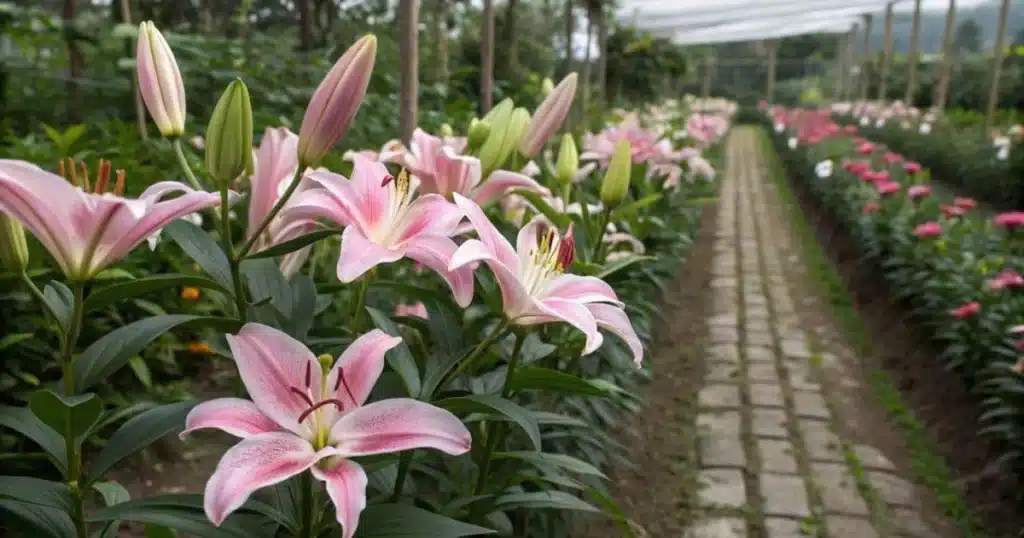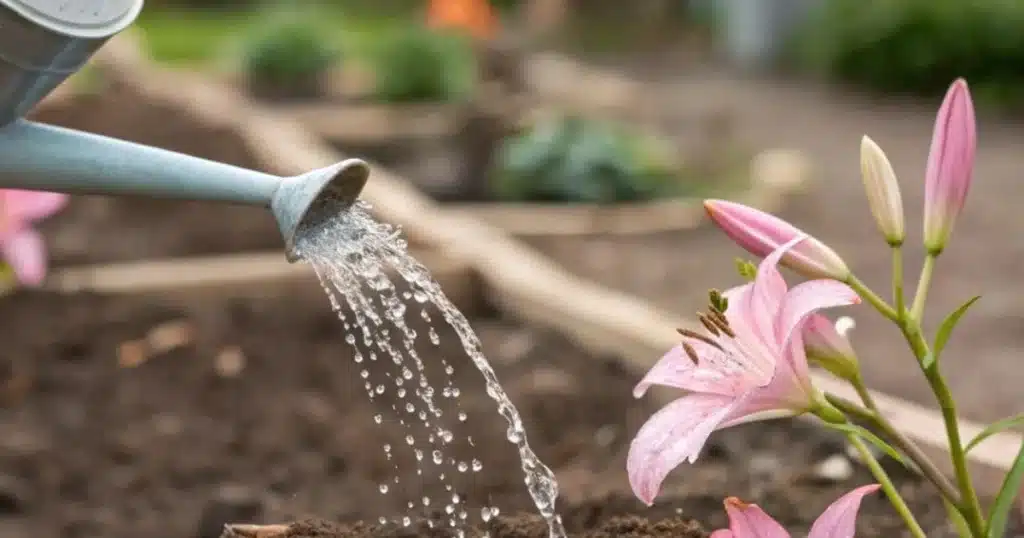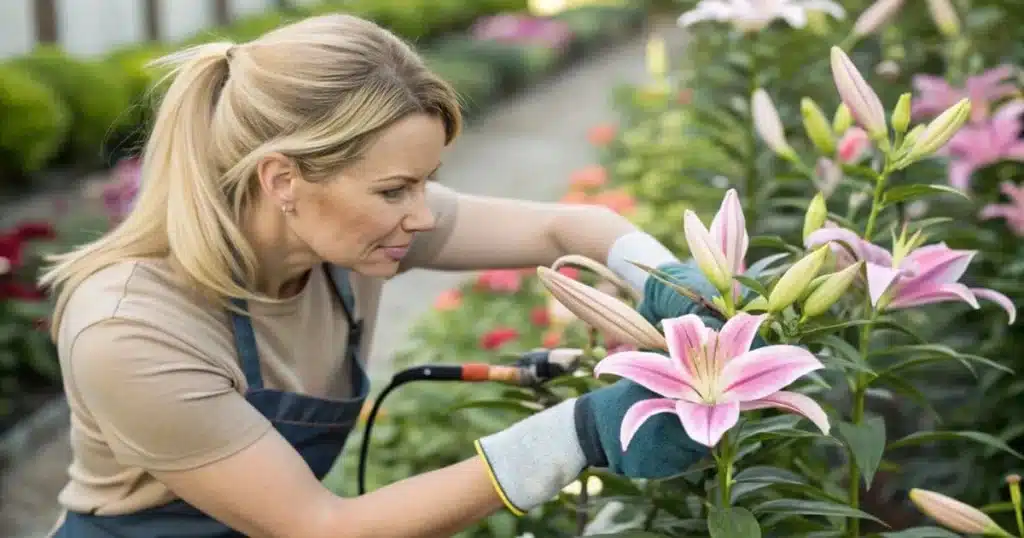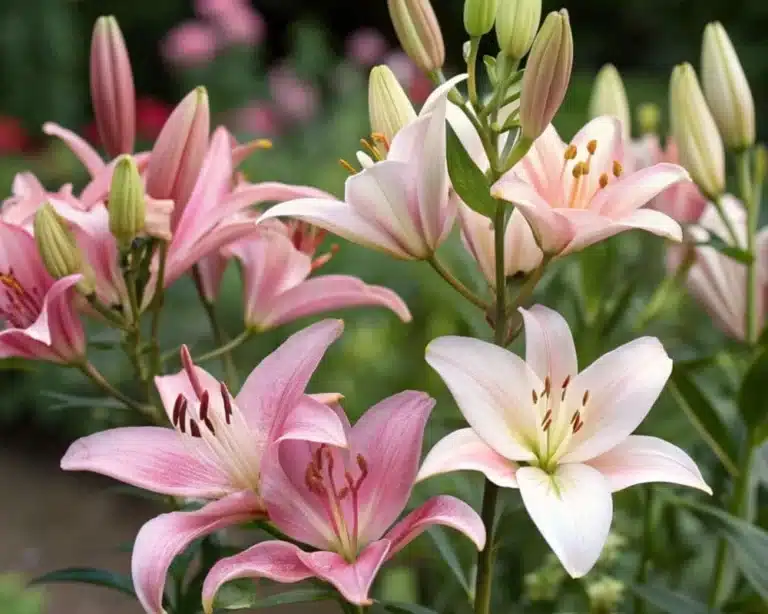Pink Lily Flowers are elegant and captivating flowers, symbolizing love and admiration. Their vibrant hues and graceful appearance make them popular in gardens and floral arrangements.
This guide covers pink lily varieties, growing conditions, care practices, and solutions to common challenges. You’ll also learn tips for maximizing blooms and using pink lilies in arrangements, helping you cultivate healthy, vibrant flowers.
Table of Contents
Understanding Pink Lily Flower Varieties
Identifying Different Types of Pink Lily Flowers
Pink lilies come in a delightful array of types, each with its own charm. The Asiatic lily is a popular choice for gardeners, known for its early bloom and vibrant colors. These lilies are often smaller and have a wide range of shades of pink, from light pastel color petal lilies to deep, rich tones. Another notable type is the Oriental lily, which boasts larger blooms and a more intense fragrance. These often feature a striking contrast with a white background pink lily, enhancing their beautiful lily appeal.
Characteristics of Pink Lily Flowers
The pink lily is not just a feast for the eyes; it offers a spectrum of pink shades, from soft pastels to bold hues. These flowers typically have trumpet-shaped blooms with six petals, each showcasing a unique color of lily. The petals often display a central star pattern, adding an extra layer of beauty. Pink lilies are also known for their ability to self-pollinate, although they thrive when assisted by pollinators like bees and butterflies.
Choosing the Right Pink Lily for Your Garden
When selecting a pink lily variety for your garden, consider the growth conditions and the aesthetic you wish to achieve. Asiatic lilies are ideal for those who prefer a vibrant pop of color early in the season. If you’re looking for something with a stronger scent and larger blooms, Oriental lilies might be the way to go. For a more subtle touch, consider a pastel color petal lily to blend seamlessly with other garden plants. Remember, each type of pink lily has its own needs and will thrive best when those are met.

Pink lilies, with their diverse shades of pink and enchanting fragrance, are a gardener’s delight. Whether you choose an Asiatic or Oriental variety, these beautiful blooms can transform any garden into a stunning visual display. For more on ornamental gardening, check out Lovers Gardening for tips and inspiration.
Optimal Growing Conditions for Pink Lily Flowers
Sunlight Requirements for Pink Lily Flowers
Pink lilies thrive best when they receive plenty of sunlight. They require at least 6 hours of direct sun each day to ensure robust growth and vibrant blooms. However, in extremely hot climates, a little afternoon shade can help prevent scorching. If you notice your lilies leaning or becoming spindly, it might be a sign they’re stretching for more light.
Soil and Watering Needs

For pink lilies, the soil is a big deal. They love well-drained, nutrient-rich soil. A good mix includes compost or well-rotted manure to boost fertility. Beautiful water lily idyll gardens often focus on proper soil preparation to ensure healthy plants. Watering should be regular but not excessive—aim for moist, not soggy soil. Overwatering can lead to root rot, so always check the soil’s moisture level before adding more water.
Temperature and Humidity Considerations
Pink lilies are quite adaptable but prefer moderate temperatures. They flourish in environments where the temperature ranges from 60°F to 75°F. During hotter months, maintaining humidity levels can be beneficial, especially in dry areas. Mulching can help retain soil moisture and keep roots cool. In regions with harsh winters, consider adding a layer of mulch to protect the bulbs from freezing temperatures.
Caring for pink lilies involves understanding their need for sunlight, the right soil, and a balance of water. With the right conditions, your lilies will offer a stunning display of color and grace throughout the blooming season.
Essential Care Practices for Pink Lily Flowers

Watering Techniques for Healthy Blooms
Proper watering is crucial for keeping pink lilies vibrant and healthy. These flowers prefer consistently moist soil, but it’s essential to avoid waterlogging, which can lead to root rot. Water lilies deeply but infrequently, allowing the top inch of soil to dry out between waterings. This encourages deep root growth, making the plants more resilient.
Fertilization Tips for Pink Lily Flowers
To support lush green foliage and abundant blooms, fertilize pink lilies with a balanced, slow-release fertilizer in early spring. A formulation with equal parts nitrogen, phosphorus, and potassium works well. Apply the fertilizer around the base of the plant, taking care not to let it touch the stems directly. Repeat the application every 6-8 weeks during the growing season for optimal results.
Pruning and Deadheading Guidelines
Pruning and deadheading are vital to maintain the plant’s health and appearance. Remove spent blooms promptly to prevent the plant from wasting energy on seed production. Cut back the flower stalks to the nearest set of leaves. Additionally, trim away any yellow or damaged leaves to improve air circulation and reduce the risk of disease.
Regular care practices like watering, fertilizing, and pruning not only enhance the beauty of your pink lilies but also ensure their longevity and vitality throughout the growing season.
Common Challenges and Solutions in Pink Lily Care
Dealing with Pests and Diseases
Pink lilies can fall victim to pests like aphids and red lily beetles. These critters can munch on the leaves and stems, leaving your plant looking ragged. To combat these pests, consider using insecticidal soap or neem oil as a natural remedy. Diseases such as botrytis blight can also affect lilies, leading to unsightly spots on the leaves. To prevent this, ensure good air circulation and avoid overhead watering.
Preventing Overwatering and Root Rot
Overwatering is a common issue that can lead to root rot, a condition where the roots become mushy and unable to absorb nutrients. To prevent this, plant your lilies in well-draining soil and check the moisture level before watering. A simple trick is to stick your finger about an inch into the soil; if it feels dry, it’s time to water.
Addressing Yellowing Leaves and Drooping Stems
Yellowing leaves and drooping stems can be signs of nutrient deficiency or improper watering. If you notice yellow leaves, it might be a lack of nitrogen. Consider applying a balanced fertilizer to boost their health. For drooping stems, ensure your lilies are getting enough sunlight and are not waterlogged. Staking can also help support taller varieties.
Taking care of pink lilies involves a bit of attention and care, but the reward of seeing them bloom beautifully in your garden is worth the effort. Keep an eye out for common issues, and you’ll enjoy vibrant, healthy flowers season after season.
Enhancing the Blooming of Pink Lily Flowers
Encouraging Longer Bloom Periods
To make your pink lilies bloom longer, you should focus on a few key practices. First, ensure they get at least six hours of sunlight each day. This helps them produce more energy, leading to more blooms per stem. Next, water them regularly but avoid overwatering, as this can cause root rot. Finally, deadhead spent flowers to direct energy back into the plant.
Maximizing Flower Size and Color
For bigger and more colorful blooms, your lilies need nutrient-rich soil. Use a balanced fertilizer during the growing season to give them the nutrients they need. Adjust the pH of your soil if necessary; lilies prefer slightly acidic to neutral soil. A healthy plant will naturally produce more vibrant and larger flowers.
Supporting Stems for Upright Growth
Pink lilies can grow quite tall, and their beautiful flowers can cause the stems to droop. To keep them upright, you might need to use stakes or plant supports. Place a support next to each stem and loosely tie the stem to it with garden twine. This not only keeps them looking tidy but also prevents stems from breaking under the weight of the blooms.
Remember, a little care goes a long way in maintaining the health and beauty of your pink lilies. With the right conditions and attention, these flowers can be a stunning addition to your garden, offering a dazzling display of color and grace.
Seasonal Care for Pink Lily Flowers
Preparing Pink Lilies for Winter
As the cold months approach, it’s time to get your pink lilies ready for winter. Mulching is crucial—pile up about 4 to 6 inches of mulch around the base of the plants. This helps delay the ground from freezing too fast, giving the roots more time to grow. If you live in an area where snow is scarce, keep the soil slightly moist throughout the winter.
Winter prep for lilies isn’t just about survival; it’s about setting them up for a strong comeback in spring.
Springtime Care for New Growth
When late spring arrives, your lilies will start to wake up. Begin by gradually removing the mulch as the shoots push through. This is also the perfect time to divide any overcrowded clumps. Just lift and split the plants, then replant with some compost to give them a nutrient boost. Don’t forget, spring is a good time to add a thin layer of compost followed by mulch to keep the roots cool.
Summer Maintenance for Vibrant Blooms
Summer’s here, and your pink lilies need consistent care to keep them blooming beautifully. Make sure they get about an inch of water each week, either from rainfall or watering. Staking might be necessary for taller varieties to prevent them from flopping over. Also, consider deadheading spent flowers to encourage more blooms and stop the plants from wasting energy on seed production. Keep an eye out for pests and diseases and tackle them promptly to maintain healthy plants.
Using Pink Lily Flowers in Floral Arrangements
Selecting the Best Stems for Cutting
When choosing pink lilies for your floral arrangements, it’s essential to pick stems that are just starting to open. This ensures they last longer once cut. Lilies with buds that are slightly open will continue to bloom, offering a more extended display of beauty. Look for stems with multiple buds to maximize blooms. Snip the stem at an angle to increase water absorption.
Arranging Pink Lilies for Longevity
Arranging Pink Lily Flowers isn’t only about aesthetics ; it’s also about making them last. Remove any leaves that would be submerged in water to prevent decay. Place the lilies in a vase with fresh water and add cut-flower food if available. Change the water every few days to keep them fresh. Consider pairing lilies with other popular flowers like roses or daisies for a vibrant mix.
Caring for Cut Pink Lilies in Vases
Once your pink lilies are in a vase, proper care is key to maintaining their elegance. Ensure they are placed in a cool spot, away from direct sunlight and drafts. Lilies can last up to two weeks with the right care. Trim the stems every few days to help them absorb water more efficiently. Keep an eye out for pollen stains; removing stamens can prevent this issue.
Pink lilies are more than just a floral choice; they bring a touch of elegance to any room. Their stunning colors and graceful shapes make them a favorite among floral enthusiasts.
To learn more about flower care tips, such as Purple Calla Lilies, Pink Peonies, or other decorative plants and flowers, check out these additional articles.
Conclusion
Caring for Pink Lily Flowers doesn’t have to be a daunting task. With just a little attention to their sunlight, water, and soil needs, you can enjoy their stunning blooms year after year. Keep them well-watered but not soggy, and make sure they receive plenty of sunlight. A layer of mulch can help keep their roots cool and healthy. Whether you’re growing them in the garden or in pots, these tips will help your pink lilies thrive. So, get out there, tend to your lilies, and enjoy the beautiful display they bring to your space.
Frequently Asked Questions
How much sunlight do pink lilies need?
Pink Lily Flowers need about 6 hours of sunlight each day to grow well and bloom beautifully.
What kind of soil is best for pink lilies?
Pink lilies like soil that drains well and is rich in nutrients. This helps them grow strong and healthy.
How often should I water my pink lilies?
Water your pink lilies regularly, but be careful not to overwater. The soil should be moist but not soggy.
Can pink lilies grow in pots?
Yes, pink lilies can grow in pots, but they need a bit more care, like regular feeding and watering.
What should I do if my pink lily leaves turn yellow?
Yellow leaves might mean your plant is getting too much water or not enough. Check the soil and adjust your watering.
How can I keep my pink lilies blooming longer?
To keep pink lilies blooming longer, make sure they get enough sunlight, water, and nutrients. Removing dead flowers also helps.
How do you care for white lilies to keep them blooming longer?
Keep white lilies in bright, indirect light and water them when the soil feels slightly dry. Remove wilted blooms and avoid placing them near fruits to prevent early wilting.


1 thought on “How to Care for Pink Lily Flowers: Tips for Healthy Blooms”